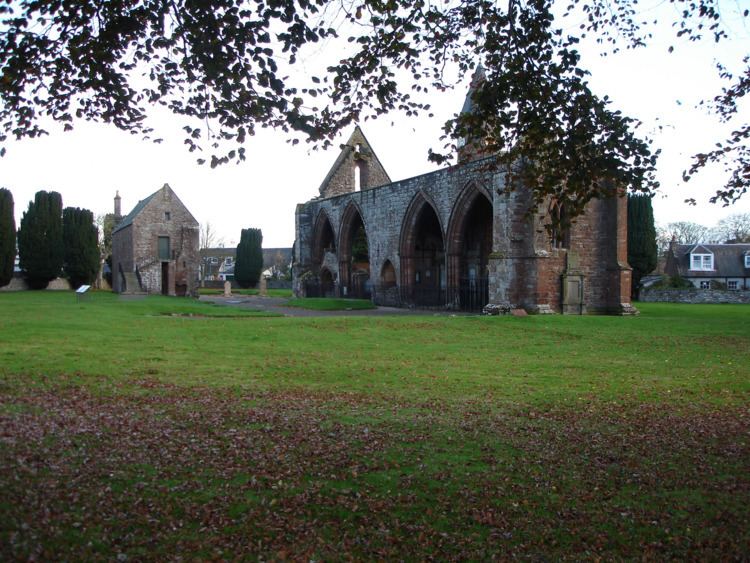Previous denomination Roman Catholicism Founder(s) unknown Phone +44 1667 460232 | Founded c. 1200 | |
 | ||
Similar Beauly Priory, Elgin Cathedral, Hugh Miller's Cottage, Groam House Museum, Highland Museum of Childhood | ||
Fortrose cathedral black isle scotland
Fortrose Cathedral was the episcopal seat (cathedra) of the medieval Scottish diocese of Ross. It is probable that the original site of the diocese was at Rosemarkie, but by the 13th century the canons had relocated a short distance to the south-west to the site known as Fortrose or Chanonry. According to Gervase of Canterbury, in the early 13th century the cathedral of Ross was manned by Céli Dé (culdees).
Contents
- Fortrose cathedral black isle scotland
- Horse and carriage to wedding at fortrose cathedral
- Chapter and prebends
- Building
- References
Horse and carriage to wedding at fortrose cathedral
Chapter and prebends
The cathedral had twenty-one prebends involving the income of thirty-one churches. After the reconstruction of the cathedral chapter in the 1250s, the bishop of Ross held Nigg and Tarbat, the archdeacon of Ross Fodderty and Killearnan (previously holding Lemlair and Logie Bride too), the dean Ardersier and Kilmuir, the chanter Kinnnettes and Suddy, the treasurer Urquhart and Logiebride ("Logie Wester"), the sub-dean Edderton and Tain (later going to the provost of the collegiate church at Tain), and the sub-chanter Inverferan and Bron (merged later as Urray).
The chancellor of Ross, appearing to hold no fixed prebend in the 13th century, later acquired Kilmorack; he exchanged it with the chanter in the 16th century for Kinnnettes and Suddy. The wealthy parishes of Rosemarkie and Cromarty were quartered between the dean, chanter, chancellor and treasurer. Likewise, was quartered between the dean, chancellor, chanter and treasurer. The western churches of Applecross, Gairloch, Kintail, Lochalsh, Lochbroom and Lochcarron were held by the chapter in common.
Alness, Contin, Cullicudden, Dingwall, Kilchrist, Kilmuir (Easter), Kiltearn, Kincardine, Kirkmichael, Logie Methet ("Logie Easter"), Roskeen (with Nonakiln) also constituted prebends for the cathedral. By the early 14th century, the abbot of Kinloss was a permanent member of the Fortrose cathedral chapter on account of holding in perpetuity the rectorship of the parish of Avoch.
Building
The Cathedral was constructed primarily of red sandstone. Two sections, the chapter house and the nave's south aisle, still stand on location. The outline of the remainder of the cathedral complex was revealed by excavations in 1873. The cathedral building appears to have begun, probably in the early-to-mid-13th century, as an "extended rectangle" with a tower in the north-west, and a chapter house and sacristy north of the choir.
The south-eastern chapel, aisle and porch were commissioned by Euphemia I, Countess of Ross in the late 14th century, but likely replaced earlier building. These portions of the cathedral resemble work at Elgin Cathedral from the same period, something that can be attributed to the fact that its bishop Alexander de Kylwos had earlier been Dean of Moray.
The south aisle, which contains two distinct chapels, has several burials. The eastern chapel is thought to contain burials of Countess Euphemia and Bishop Robert Cairncross. The tomb in the western chapel is, reputedly, Bishop John Fraser. Alexander of Islay, Earl of Ross and Lord of the Isles, was buried in the cathedral, but the location is not known. On the ceiling of the western chapel there are two heraldic bosses, representing Earl Alexander and Bishop John Bulloch.
After the Scottish Reformation it continued to be used as a church for the town. It began to fall apart in the later 16th and early 17th century, though the sacristy and chapter house were still used for local gatherings of officials in the 18th century. Like other Scottish ex-cathedrals, its grounds remained in use as a graveyard. The government took over responsibility for its care in 1851.
